Faculty publications
Mangos, Chiles, and Truckers: The Business of Transnationalism
By: Roberto Álvarez
(Univ. of Minnesotta Press, 2005)
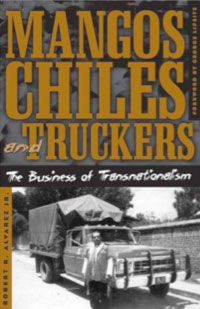 Mangos, Chiles, and Truckers illuminates how local groups and individuals engage the global world and capitalism in creative ways. Robert Alvarez analyzes how the produce and trucking industries in Mexico affect the organization of work, community, and social space for miles on either side of the international border. Taking an ethnographic approach, Alvarez focuses on the impact transnational economic policies like NAFTA have had on growers of mangos and chiles in Mexico, those who transport the produce across the U.S.–Mexico border, and the immigrant communities receiving these goods in the United States.
Mangos, Chiles, and Truckers illuminates how local groups and individuals engage the global world and capitalism in creative ways. Robert Alvarez analyzes how the produce and trucking industries in Mexico affect the organization of work, community, and social space for miles on either side of the international border. Taking an ethnographic approach, Alvarez focuses on the impact transnational economic policies like NAFTA have had on growers of mangos and chiles in Mexico, those who transport the produce across the U.S.–Mexico border, and the immigrant communities receiving these goods in the United States.
Contrary to common perceptions in postnational studies, Alvarez shows how the nation-state enacts and connects with the transnational, crossing borders in ways that underwrite new technology and trade. Emphasizing the importance and control of the nation-state in the global process, Mangos, Chiles, and Truckers demonstrates how people make meaning as they struggle with the economic circumstances of their lives, creating cultural traditions and giving new value to old customs and practices.
Familia: Migration and Adaptation in Baja and Alta California, 1800-1975
By: Roberto Álvarez
(Univ. of California Press, 1991)
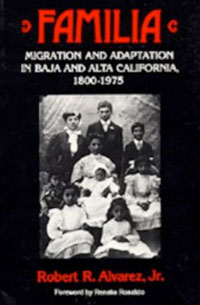 An interesting study that concentrates on the human aspects of migration over generations. Alvarez, an anthropologist, denies that Baja Californians migrated to the United States for solely economic reasons. Rather, they followed a centuries-old "regional-familial" tradition of northward movement. The process did not break down family structure, but instead strengthened it through development of an extended kinship network. Alvarez's reference to individuals and families, including his own, make this an unusual and persuasive volume. The major portion deals with the late 19th through mid-20th centuries; contains useful genealogical diagrams; and is buttressed by extensive oral interviews. Recommended for academic and special libraries.
An interesting study that concentrates on the human aspects of migration over generations. Alvarez, an anthropologist, denies that Baja Californians migrated to the United States for solely economic reasons. Rather, they followed a centuries-old "regional-familial" tradition of northward movement. The process did not break down family structure, but instead strengthened it through development of an extended kinship network. Alvarez's reference to individuals and families, including his own, make this an unusual and persuasive volume. The major portion deals with the late 19th through mid-20th centuries; contains useful genealogical diagrams; and is buttressed by extensive oral interviews. Recommended for academic and special libraries.
Campaigning to the New American Electorate: Advertising to Latino Voters
By: Marisa A. Abrajano
(Stanford University Press, 2010)
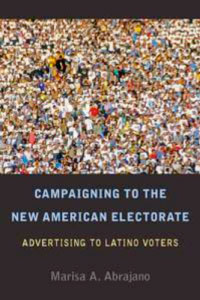 Presuming that a strong relationship exists between one's identity and political behavior, American politicians have long targeted immigrant and ethnic communities based on their shared ethnic or racial identity. But to what extent do political campaign messages impact voters' actual decisions and behaviors?
Presuming that a strong relationship exists between one's identity and political behavior, American politicians have long targeted immigrant and ethnic communities based on their shared ethnic or racial identity. But to what extent do political campaign messages impact voters' actual decisions and behaviors?
This new book is one of the first to examine and compare the campaign efforts used to target Latinos with those directed at the rest of the electorate. Specifically, it focuses on televised Spanish and English-language advertising developed for the 2000 and 2004 presidential elections, as well as for dozens of congressional and statewide contests from 2000–2004. Author Marisa Abrajano's research reveals exposure to these televised political ads indeed impacts whether Latinos turn out to vote and, if so, for whom they vote. But the effect of these advertising messages is not uniform across the Latino electorate. Abrajano explores the particular factors that affect Latinos' receptivity to political ads and offers key findings for those interested in understanding how to mobilize this critical swing group in American politics.
New Faces, New Voices: The Hispanic Electorate in America
By: Marisa A. Abrajano and R. Michael Alvarez
(Princeton University Press, 2010)
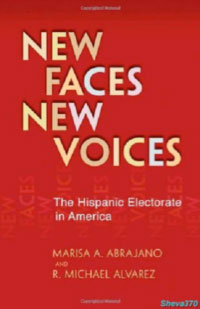 Making up 14.2 percent of the American population, Hispanics are now the largest minority group in the United States. Clearly, securing the Hispanic vote is more important to political parties than ever before. Yet, despite the current size of the Hispanic population, is there a clear Hispanic politics? Who are Hispanic voters? What are their political preferences and attitudes, and why? The first comprehensive study of Hispanic voters in the United States, New Faces, New Voices paints a complex portrait of this diverse and growing population. Examining race, politics, and comparative political behavior, Marisa Abrajano and R. Michael Alvarez counter the preconceived notion of Hispanic voters as one homogenous group. The authors discuss the concept of Hispanic political identity, taking into account the ethnic, generational, and linguistic distinctions within the Hispanic population. They compare Hispanic registration, turnout, and participation to those of non-Hispanics, consider the socioeconomic factors contributing to Hispanics' levels of political knowledge, determine what segment of the Hispanic population votes in federal elections, and explore the prospects for political relationships among Hispanics and non-Hispanics. Finally, the authors look at Hispanic opinions on social and economic issues, factoring in whether these attitudes are affected by generational status and ethnicity. A unique and nuanced perspective on the Hispanic electoral population, New Faces, New Voices is essential for understanding the political characteristics of the largest and fastest growing group of minority voters in the United States.
Making up 14.2 percent of the American population, Hispanics are now the largest minority group in the United States. Clearly, securing the Hispanic vote is more important to political parties than ever before. Yet, despite the current size of the Hispanic population, is there a clear Hispanic politics? Who are Hispanic voters? What are their political preferences and attitudes, and why? The first comprehensive study of Hispanic voters in the United States, New Faces, New Voices paints a complex portrait of this diverse and growing population. Examining race, politics, and comparative political behavior, Marisa Abrajano and R. Michael Alvarez counter the preconceived notion of Hispanic voters as one homogenous group. The authors discuss the concept of Hispanic political identity, taking into account the ethnic, generational, and linguistic distinctions within the Hispanic population. They compare Hispanic registration, turnout, and participation to those of non-Hispanics, consider the socioeconomic factors contributing to Hispanics' levels of political knowledge, determine what segment of the Hispanic population votes in federal elections, and explore the prospects for political relationships among Hispanics and non-Hispanics. Finally, the authors look at Hispanic opinions on social and economic issues, factoring in whether these attitudes are affected by generational status and ethnicity. A unique and nuanced perspective on the Hispanic electoral population, New Faces, New Voices is essential for understanding the political characteristics of the largest and fastest growing group of minority voters in the United States.
The Spectacle of Japanese American Trauma: Racial Performativity and World War II
By: Emily Roxworthy
(University of Hawaii Press, 2008)
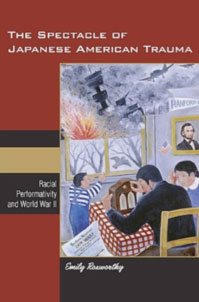 In The Spectacle of Japanese American Trauma, Emily Roxworthy contests the notion that the U.S. government's internment policies during World War II had little impact on the postwar lives of most Japanese Americans. After the curtain was lowered on the war following the bombings of Hiroshima and Nagasaki, many Americans behaved as if the "theatre of war" had ended and life could return to normal. Roxworthy demonstrates that this theatrical logic of segregating the real from the staged, the authentic experience from the political display, grew out of the manner in which internment was agitated for and instituted by the U.S. government and media. During the war, Japanese Americans struggled to define themselves within the web of this theatrical logic, and they continue to reenact this trauma in public and private to this day.
In The Spectacle of Japanese American Trauma, Emily Roxworthy contests the notion that the U.S. government's internment policies during World War II had little impact on the postwar lives of most Japanese Americans. After the curtain was lowered on the war following the bombings of Hiroshima and Nagasaki, many Americans behaved as if the "theatre of war" had ended and life could return to normal. Roxworthy demonstrates that this theatrical logic of segregating the real from the staged, the authentic experience from the political display, grew out of the manner in which internment was agitated for and instituted by the U.S. government and media. During the war, Japanese Americans struggled to define themselves within the web of this theatrical logic, and they continue to reenact this trauma in public and private to this day.
The political spectacles staged by the FBI and the American mass media were heir to a theatricalizing discourse that can be traced back to Commodore Matthew Perry's "opening" of Japan in 1853. Westerners, particularly Americans, drew upon it to orientalize--disempower, demonize, and conquer—those of Japanese descent, who were characterized as natural-born actors who could not be trusted. Roxworthy provides the first detailed reconstruction of the FBI's raids on Japanese American communities, which relied on this discourse to justify their highly choreographed searches, seizures, and arrests. Her book also makes clear how wartime newspapers (particularly those of the notoriously anti-Asian Hearst Press) melodramatically framed the evacuation and internment so as to discourage white Americans from sympathizing with their former neighbors of Japanese descent.
Roxworthy juxtaposes her analysis of these political spectacles with the first inclusive look at cultural performances staged by issei and nisei (first- and second-generation Japanese Americans) at two of the most prominent "relocation centers": California's Manzanar and Tule Lake. The camp performances enlarge our understanding of the impulse to create art under oppressive conditions. Taken together, wartime political spectacles and the performative attempts at resistance by internees demonstrate the logic of racial performativity that underwrites American national identity. The Spectacle of Japanese American Trauma details the complex formula by which racial performativity proved to be a force for both oppression and resistance during World War II.
Black Arts West: Culture and Struggle in Postwar Los Angeles
By: Daniel Widener
(Duke University Press, 2010)
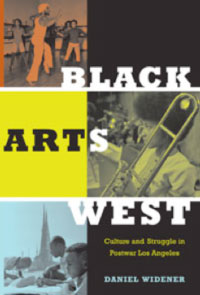 From postwar efforts to end discrimination in the motion-picture industry, recording studios, and musicians’ unions, through the development of community-based arts organizations, to the creation of searing films critiquing conditions in the black working class neighborhoods of a city touting its multiculturalism—Black Arts West documents the social and political significance of African American arts activity in Los Angeles between the Second World War and the riots of 1992. Focusing on the lives and work of black writers, visual artists, musicians, and filmmakers, Daniel Widener tells how black cultural politics changed over time, and how altered political realities generated new forms of artistic and cultural expression. His narrative is filled with figures invested in the politics of black art and culture in postwar Los Angeles, including not only African American artists but also black nationalists, affluent liberal whites, elected officials, and federal bureaucrats.
From postwar efforts to end discrimination in the motion-picture industry, recording studios, and musicians’ unions, through the development of community-based arts organizations, to the creation of searing films critiquing conditions in the black working class neighborhoods of a city touting its multiculturalism—Black Arts West documents the social and political significance of African American arts activity in Los Angeles between the Second World War and the riots of 1992. Focusing on the lives and work of black writers, visual artists, musicians, and filmmakers, Daniel Widener tells how black cultural politics changed over time, and how altered political realities generated new forms of artistic and cultural expression. His narrative is filled with figures invested in the politics of black art and culture in postwar Los Angeles, including not only African American artists but also black nationalists, affluent liberal whites, elected officials, and federal bureaucrats.
Along with the politicization of black culture, Widener explores the rise of a distinctive regional Black Arts Movement. Originating in the efforts of wartime cultural activists, the movement was rooted in the black working class and characterized by struggles for artistic autonomy and improved living and working conditions for local black artists. As new ideas concerning art, racial identity, and the institutional position of African American artists emerged, dozens of new collectives appeared, from the Watts Writers Workshop, to the Inner City Cultural Center, to the New Art Jazz Ensemble. Spread across generations of artists, the Black Arts Movement in Southern California was more than the artistic affiliate of the local civil-rights or black-power efforts: it was a social movement itself. Illuminating the fundamental connections between expressive culture and political struggle, Black Arts West is a major contribution to the histories of Los Angeles, black radicalism, and avant-garde art.
Forthcoming:
• Gangster, Cop, Soldier, Spy: The Many Faces of Transnational Violence between Los Angeles and San Salvador, by: Elana Zilberg (forthcoming, Duke University Press, 2011).
• Face Value: Expressions of Want and Wealth in the Americas, by: David Pedersen (forthcoming, University of Chicago Press, 2011).

